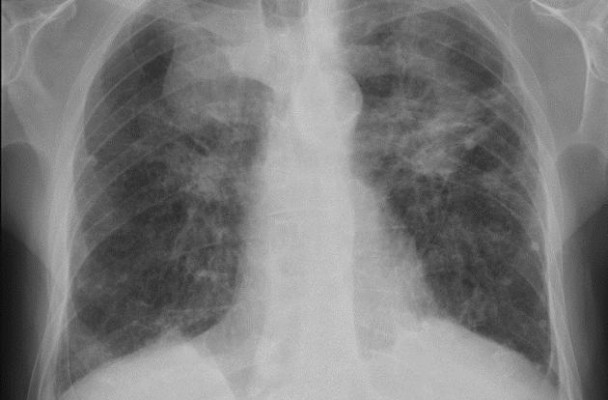DOL and NIOSH Create B-Reader Quality Assurance Program

A lung x-ray of a miner with Progressive Massive Fibrosis (PMF), the most severe form of black lung.
Important news in the black lung benefits system: The federal government has created an interagency program to revoke the “B-Reader” certification of biased physicians.
Background
NIOSH’s B-Reader program certifies a physician’s expertise in identifying and classifying pneumoconioses on x-ray. Being a B-Reader results in the physician’s x-ray readings being given more weight in black lung benefits claims. These readings are especially important in claims concerning the form of severe black lung known as “complicated coal workers’ pneumoconiosis” or “progressive massive fibrosis” because these claims usually turn entirely on the weight given to varying x-ray readings.
There is a concern that some physicians may be reading x-rays one way to pass the B-Reader examination and another way in practice (e.g., see below description of Dr. Paul Wheeler). There is a need for a system to monitor and police how B-Readers are actually reading contested x-rays.
B-Reader Quality Assurance Program
Yesterday, just such a system was announced. The Department of Labor’s Office of Workers’ Compensation Programs (OWCP) and the Center for Disease Control’s National Institute for Occupational Safety and Health (NIOSH) created a quality assurance program for x-ray readings by B-Readers whose readings are submitted as evidence in federal black lung benefits claims.
The Memorandum of Understanding says that its purpose is to “to identify B readers who frequently misclassify large opacities associated with pneumoconiosis and to minimize, if not eliminate, their impact on the evaluation of black lung claims.” The MOU recognizes the subjective nature of reading x-rays, but says, “a B reader’s classifications should not markedly deviate from mainstream classifications.”
As explained by the MOU, the program would basically work like this:
When OWCP receives a B-reader’s reading in a case of contested complicated black lung and that reading differs from all the readings by other B-readers employed by the other party in the claim, then the reading(s) would count as one “case of disagreement.” When a B-Reader has 5 cases of disagreement within a 2-year period, then OWCP would refer the readings to NIOSH for evaluation. After NIOSH confirms that the readings meet the criteria, NIOSH would then perform a quality assurance investigation.
NIOSH’s procedures for its investigations have not been developed yet, but the MOU says they will include:
(1) informing B readers that quality assurance investigation has been initiated; (2) developing and evaluating evidence relevant to OWCP’s submission; (3) identifying possible actions NIOSH may take at the conclusion of an investigation; (4) allowing B readers an opportunity to challenge the initial investigation findings and notifying them of the final results of the investigation; and (5) informing OWCP whether the investigated B reader’s certification remains effective or is suspended or revoked.
The criteria can be somewhat complicated and are best explained in the MOU by a series of examples over seven pages, but the essential trigger for a “case of disagreement” is when readings “differ from all other NIOSH-certified B readers employed by the other side.”
This is another reform to come out of Breathless and Burdened—the Pulitzer Prize winning series by the Center for Public Integrity and ABC News. In one of the interviews, Dr. Paul Wheeler expressed his skepticism that the standard films used in the B-Reader examination even showed pneumoconiosis. Yet, Dr. Wheeler passed the B-Reader examination decade after decade even though in practice he never once recognized a case of complicated black lung in more than 3,400 x-rays. This suggests that Dr. Wheeler may have read the standard films as positive for complicated black lung when taking the B-Reader examination, but read similar x-rays as negative in practice.
There are many questions that the MOU raises but two major ones are: (1) who at NIOSH will make determinations about whether the disputed cases are legitimate borderline cases in which reasonable minds can disagree or whether the cases demonstrate bias?, and (2) how much control will attorneys have over the process by deciding which readings to submit to OWCP?
The second question is particularly important in cases in which one party hires a B-reader but then chooses not to submit the reading because the reading is not consistent with the party’s interests. For example, a coal company’s attorney hires a B-Reader who provides a reading that the miner has complicated black lung; the attorney then decides not to submit the reading in the claim because it would not advance his client’s defense. This unsubmitted readings may become available to the miner seeking benefits, however, through the process of discovery—or if the proposed regulations are finalized—through mandatory disclosure. In this situation, the miner may end up submitting the reading, even though the radiologist was hired by the operator. Because the MOU talks about readings that “differ from all other NIOSH-certified B readers employed by the other side” then how should such a reading be treated under the criteria? Because the potential for mandatory disclosure should make this scenario more common, this is a question that OWCP and NIOSH will likely need to address.
Regardless of uncertainties around the edges though, the creation of this program appears to be a definite improvement in the black lung benefits program. It provides more assurance that those physicians who NIOSH certifies as B-Readers are providing reliable readings and should result in more accurate benefits decisions.
2 Responses to “DOL and NIOSH Create B-Reader Quality Assurance Program”
Good news! Tnx Evan
[…] This news comes on the heels of an announcement by DOL and NIOSH of a quality assurance program for B-Readers who provide x-ray readings for black lung claims (see today’s previous post here). […]
Comments are closed.